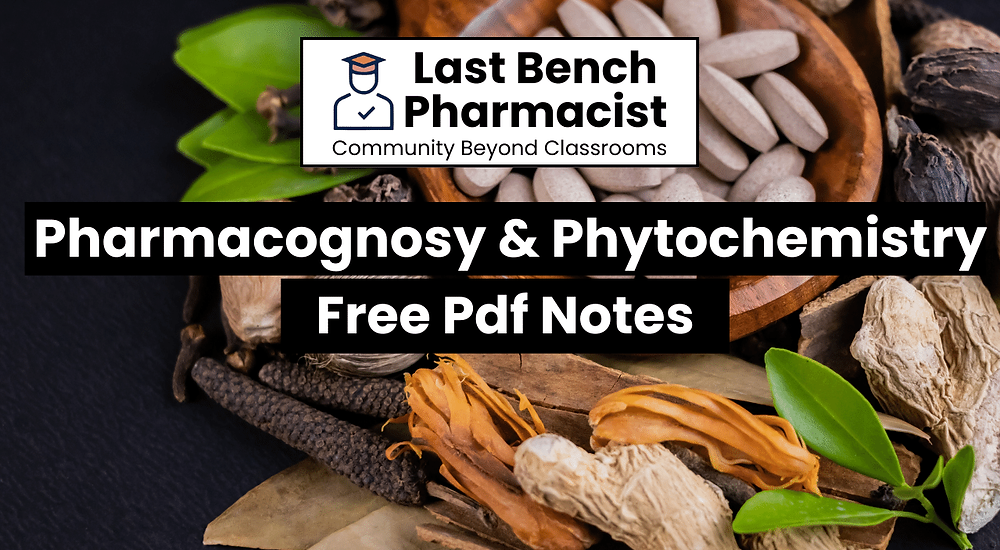



#bpharmnotes #bpharmPharmacognosynotes #bpharmpdfnotes
Forget boring botany classes, this ain’t your grandma’s flower arranging. We’re diving into the wild world of plant drugs, where nature gets all science-y and produces potent chemicals that can cure everything from coughs to cancer. Think of it as a jungle safari for your brain, where you’ll hunt for alkaloids, flavonoids, and terpenes like they’re jungle treasure. We’ll unlock the secrets of how plants make these mind-blowing molecules, how they get extracted and turned into fancy pills, and even learn how to grow your own miniature pharmacy in your backyard (maybe not the morphine poppies, though). Sure, there might be some Latin names and long chemical formulas, but hey, at least it’s more fun than memorizing random facts about birdwatching. So, grab your magnifying glass and your thirst for knowledge, download these B Pharm Pharmacognosy and Phytochemistry Pdf Notes, and get ready to discover the plant-powered secrets of the universe (or at least ace your next exam)!
Scope:
The subject involves the fundamentals of Pharmacognosy like scope, classification of crude drugs, their identification and evaluation, phytochemicals present in them and their medicinal properties.
Objectives: Upon completion of the subject student shall be able to:
To know the techniques in the cultivation and production of crude drugs
To know the crude drugs, their uses and chemical nature
Know the evaluation techniques for the herbal drugs
To carry out the microscopic and morphological evaluation of crude drugs
(a) Definition, history, scope and development of Pharmacognosy
(b) Sources of Drugs – Plants, Animals, Marine & Tissue culture
(c) Organized drugs, unorganized drugs (dried latex, dried juices, dried extracts, gums and mucilages, oleoresins and oleo- gum -resins).
Alphabetical, morphological, taxonomical, chemical, pharmacological, chemo and sero taxonomical classification of drugs
Adulteration of drugs of natural origin. Evaluation by organoleptic, microscopic, physical, chemical and biological methods and properties. Quantitative microscopy of crude drugs including lycopodium spore method, leafconstants, camera lucida and diagrams of microscopic objects to scale with camera lucida
Cultivation and Collection of drugs of natural origin Factors influencing cultivation of medicinal plants. Plant hormones and their applications. Polyploidy, mutation and hybridization with reference to medicinal plants
Conservation of medicinal plants
Historical development of plant tissue culture, types of cultures, Nutritional requirements, growth and their maintenance. Applications of plant tissue culture in pharmacognosy. Edible vaccines
Role of Pharmacognosy in allopathy and traditional systems of medicine namely, Ayurveda, Unani, Siddha, Homeopathy and Chinese systems of medicine.
Definition, classification, properties and test for identification of Alkaloids, Glycosides, Flavonoids, Tannins, Volatile oil and Resins
Study of biological source, chemical nature and uses of drugs of natural origin containing following drugs:-
Fibers – Cotton, Jute, Hemp Hallucinogens, Teratogens, Natural allergens
General introduction, detailed study with respect to chemistry, sources, preparation, evaluation, preservation, storage, therapeutic used and commercial utility as Pharmaceutical Aids and/or Medicines for the following
Primary metabolites:
Carbohydrates: Acacia, Agar, Tragacanth, Honey
Proteins and Enzymes : Gelatin, casein, proteolytic enzymes (Papain, bromelain, serratiopeptidase, urokinase, streptokinase, pepsin).
Lipids(Waxes, fats, fixed oils) : Castor oil, Chaulmoogra oil, Wool Fat, Bees Wax
Novel medicinal agents from marine sources